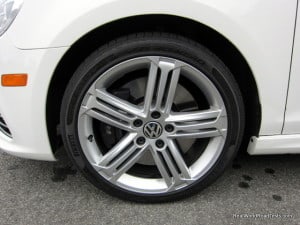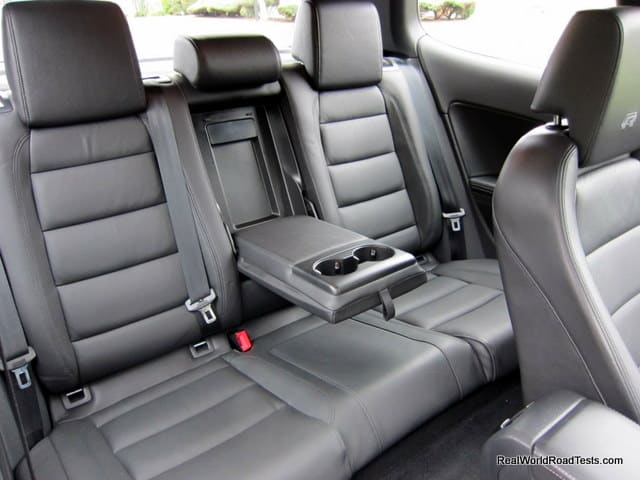Introduction
After testing a 2011 GTI, we were very impressed with the car. One of our editors even bought one. Yes, the GTI is a great daily driver that feels like a car costing thousands more than it does, but we found ourselves wondering what the car would be like with more power, a sportier suspension, and more luxurious features. Fortunately, we were given the opportunity to test the 2012 Golf R.
The Golf R is the replacement to the Golf R32 and comes with a turbocharged 2.0 liter 4-cylinder engine instead of the Golf R32’s 3.2 liter VR6. Improvements over the R32 include more power and increased performance, while attaining better gas mileage. This is a limited production car with only 5,000 being produced for the 2012 model year, and another 5,000 for 2013.
While the 2012 GTI starts at $23,995, the Golf R starts at $33,990. That’s almost $10,000 more than the base GTI. We wanted to take a closer look at the Golf R to see what you get for the extra dough, and if we feel it’s worth the extra money.
Let’s be fair though. The Golf R is not available in a “stripper” version with only performance upgrades. According to VW, “The base Golf R is a sophisticated and luxurious performance car, with a high level of standard equipment” and its mission is to provide “sophisticated and understated performance”. Our Golf R 2-door came equipped with many comfort features including sunroof, touch screen navigation system, premium audio system, heated leather seats, automatic climate control, and xenon headlamps just to name a few. This means, to really see how much more the Golf R really costs over the GTI, we’ll need to check off some additional items on the options sheet in the GTI. The closest GTI model to our Golf R is the 2-door Autobahn that starts at $29,995 before destination, which is approximately $5,500 less than the base price of our car excluding the items that come standard in the Golf R that are not available in the GTI .
Performance
A common misconception is that the Golf R uses the same engine as the GTI, but with a bigger turbocharger. The reality is this car uses a version of the EA113 2.0 liter turbocharged inline 4-cylinder engine used in the Audi TTS and has a timing belt, instead of the EA888 engine from the GTI that uses a timing chain. The engine in the Golf R uses direct fuel injection and double overhead camshafts with variable intake timing to produce 256 horsepower (56 hp more than the GTI) at 6,000 RPM, and 243 lb-ft torque (36 more than the GTI) @ 2,400 RPM. The Golf R also has a reinforced cylinder block, stronger connecting rods, and an upgraded turbocharger. Power to weight ratio for the Golf R is approximately 13.0 lb./hp vs 15.2 lb/hp for the GTI.
Once underway, acceleration feels very strong, but not linear. 0 to 60 MPH came in 6.2 seconds, which is less than a second faster than our GTI. Although not a staggerig performance time, it feels faster than the numbers indicate. Acceleration is adequate at low RPMs but once you hit 3,000 RPM hold on tight because this car blasts forward with enough force to throw you back in your seat. The Golf R is only available in all-wheel drive (AWD) while the GTI is only available in front-wheel drive (FWD). Off the line, the Golf R exhibited none of the wheel spin or torque steer associated with the FWD GTI. The engine sound is always present and we had different opinions of it. Some found it too quiet for a performance version of a car, and others found it a little loud for a vehicle with this level of luxury. Our solution would be for VW to include a system that automatically adjusts the exhaust note based on throttle input providing a more aggressive sound with greater throttle input. Our test car exhibited a throttle off flatulence shortly after lifting off the throttle, which quickly became another talking point for us. At highway speeds wind and road noise are controlled and weren’t bothersome.
The Golf R is only available with a close ratio 6-speed manual transmission. It shifts smoothly with fairly short throws. The clutch uptake is light and is not fatiguing in heavy traffic.
The steering is slightly quicker than the GTI’s and provides a sportier feel. The Golf R automatically varies the steering feel based on the vehicle’s speed. It is pleasantly firm when driving at highway speeds and lighter yet still firm at crawling speeds. We found maneuverability around parking lots a breeze with its tight turning circle. It also has a mild self-centering action which compensates for crosswinds.
The handling is sporty and athletic thanks to its independent suspension with struts, lower control arms, coil springs, telescopic dampers, and anti-roll bar in the front, and a multilink setup in the rear with coil springs, telescopic dampers, and anti-roll bar. Although it’s stiffer than the GTI, it’s not as agile as lighter weight sports cars like the Scion FR-S and Subaru BRZ, but it’s tighter than you’ll ever need on public roads. There is some mild body lean in hard cornering, but that’s a good thing most of the time because the ride is not punishing, although it is firm and jittery over broken pavement. Overall comfort in this car is great over a long trip. We were in the vehicle for several hours straight and traveled from Connecticut to New Hampshire and back without feeling any discomfort.
The brakes in the Golf R are bigger than in the GTI for better stopp ing performance. The Golf R has vented 13.6-inch diameter front and 12.2-inch rear discs. That’s up from 12.3-inch diameter vented front and 10.7-inch solid rear discs in the GTI. The Golf R also includes electronic brake pressure distribution (EBS) that modifies brake pressure at each wheel as needed for better control, and hydraulic brake assist (HBA) that helps increase the brake pressure and activates the ABS if it feels you’re breaking in an emergency. Breaking is strong and it has a nice pedal feel.
ing performance. The Golf R has vented 13.6-inch diameter front and 12.2-inch rear discs. That’s up from 12.3-inch diameter vented front and 10.7-inch solid rear discs in the GTI. The Golf R also includes electronic brake pressure distribution (EBS) that modifies brake pressure at each wheel as needed for better control, and hydraulic brake assist (HBA) that helps increase the brake pressure and activates the ABS if it feels you’re breaking in an emergency. Breaking is strong and it has a nice pedal feel.
“R” is for Racing
With the Golf R being touted as a track worthy car, we decided to take it to New Hampshire Motor Speedway to test it out. What we determined is that this car is very capable and we had no problems keeping up with or passing many much more expensive cars on the track. All the power from the engine was transferred directly to the road with no wheel spin thanks to AWD and a Haldex clutch pack. VW calls it 4Motion and it mechanically works the same way as Audi’s Quattro system. Under normal driving conditions approximately 97.5% of torque is sent to the front. However, once slippage is detected at the front drive wheels, it automatically increases the amount of torque sent to the rear wheels, up to 100%. During one of our sessions the track was wet. This was a perfect opportunity to test the AWD system. As other cars struggled to maintain traction, the Golf R was able to put the power down and thus accelerate past them.
Slowing down at first was another story. With its all-season tires and a wet track, there was not a lot of grip and we would feel the ABS eagerly activating under moderate braking. The brakes did, however, help us maintain control of the vehicle. Braking and grip improved significantly once the pavement dried up.
What stood out most though is its great balance between the front and rear of the car. We had no fear of excessive over-steer, under-steer or spinning at high speeds, even with full throttle in a turn. Also, even with the traction control on (the electronic stability control can’t be turned off) the Golf R did an amazing job keeping the vehicle safe and in control while maintaining a high level of fun. Although stability control can’t be turned off, we didn’t find it unnecessarily restrictive and it engaged only when necessary. For more information on how you can take your streetcar out on high performance driving events, click here.
Exterior
Where styling in cars like the Mitsubishi Lancer Evolution and Subaru WRX STI scream “Boy Racer!” the Golf R provides a more subtle, mature and sophisticated look. At first glance, the Golf R looks pretty much like the GTI. In front, there’s a gloss black radiator grille with “R” logo, the bumper was modified to include LED daytime running lights and three large black air intakes to help cool the engine. The side view is differentiated with body colored side skirts that run along the lower edge of the car, new 5-spoke duel slotted 18” aluminum allow wheels with Pirelli P Zero Nero 225/40 R18 92H all-season tires (same tires as the GTI), gloss black brake calipers with “R” logo, and gloss black exterior mirrors. The rear view is further differentiated by a redesigned bumper that features a gloss black diffuser, a slightly larger spoiler, an “R” badge, and central twin exhaust pipes.
Interior
As with the exterior, the interior of the Golf R has been tastefully enhanced for a mature and sophisticated look. When entering the vehicle, the door sills are decorated with aluminum kick plates containing the “R” logo. The 8-way manual adjustable seats are covered with leather, have very supportive side bolsters, and contain power lumbar adjustment. Seat travel is long to accommodate very tall and short drivers. The leather wrapped steering wheel retains the flat bottom of the GTI, and is both height adjustable and telescopic. The steering wheel spokes contain functions for making phone calls, audio controls and controls for the multi-function display with trip computer. The instrument cluster is unique and is very easy to read with blue needles and clear lighting. It houses the speedometer, tachometer, water temperature, fuel level gauge, and a multi-function display. Other nice touches include aluminum trim for the dashboard, doors and pedals. The center console armrest is nicely padded and is adjustable to several different heights.
The Golf R also includes features like Automatic dual-zone climate control, aux-in, a Media Device Interface with iPod connectivity, and Bluetooth. Our Golf R had the optional Sunroof that stops in multiple positions, navigation with touchscreen which we found not very self-intuitive and fairly difficult to use, a 300-watt Dynaudio sound system that sounds great; and Keyless entry with push-button start.
Entry into the rear seats requires a bit of flexibility. To get back there, you have to lift a lever on the front seat back and slide the seat forward. Then you have to climb in and rotate into position. To move the front seat back into position you have to lift the lever on the front seat back again, but this time with more force or the seat will lock and you will be unable to move it. Once back there though, at 6’1”, I had enough legroom and headroom to get comfortable. Only two people will fit in the back comfortably, but three could squeeze back there in a pinch. The rear seats are also capable of fitting child car seats, but the rear windows don’t go down. If rear seats access and rear windows that open are important, there is a 4-door model available.
Outward visibility is pretty good. We had no problems seeing out front, to the sides or to the back. However the C-pillars are thick which hinders rear corner visibility somewhat. This car does not come with a rear view camera. Seeing a small child or pet below the sight line in the rear of the vehicle may be difficult.
Storage
The tailgate in the Golf R lifts high enough for me not to bump my head at 6’1”. With its hatchback versatility, and 15.3 cubic feet of storage space the Golf R offers a useful cargo area with a low load floor, and the flexibility to fold the rear seats 60/40. Other storage includes a glove box, large carpeted door pockets, center storage console (with only a small amount of storage capacity), two center cup holders in front, two cup holders in the rear, and front seatback storage pockets. Beneath the floor of the trunk is a compact spare tire.
Safety
As of the date this article was published, the IIHS hasn’t published results for the 2012 Golf R. However they did publish results for the 4-door GTI which earned a “Top Safety Pick” for good performance (their highest rating) in moderate overlap front, side, rollover, and rear tests. No small overlap front tests have been conducted for this vehicle.
The 2012 Golf R comes with many standard safety features including Electronic Stability Control (ESC), Anti-Slip Regulation (ASR), Electronic Differential Lock (EDL), Driver and passenger front and front side airbags with Side Curtain Protection® head airbags for front and rear passengers, and Volkswagen’s Intelligent Crash Response System which shuts off the fuel pump, unlocks the doors, and automatically switches on the hazard lights if the car is involved in certain types of collisions.
The Golf R also comes with a hill hold feature that automatically applies the parking brake while using the brakes to come to a stop, which prevents the car from rolling backwards or forwards until the accelerator pedal is pressed.
Availability
The Golf R is available in 2-door and 4-door. Each one comes in two trim levels, Golf R and Golf R with Sunroof and Navigation. All Golf Rs are luxurious performance cars with high levels of standard equipment.
The 2-door Golf R starts at $33,990 and comes equipped with Bi-Xenon headlights; dual-zone Climatronic air conditioning; cruise control; leather-trimmed multifunction steering wheel; power windows with auto up/down function; leather seating surfaces; 60/40-split folding rear seat with pass through; aluminum pedals; a leather shifter knob and brake lever; and Bluetooth technology. The eight-speaker sound system has an in-dash six-CD changer, AM/FM/SiriusXM Satellite Radio, and auxiliary input jack along with an iPod adapter.
The 2-door Golf R with Sunroof and Navigation starts at $35,490 and adds a power tilt-and-slide sunroof; Keyless Entry with push-button start; touchscreen navigation system; and the eight-channel 300-watt Dynaudio premium sound system.
For 2013, the Golf R continues with no changes over the 2012 models and will continue to be produced in limited quantities.
Competitors of the Golf R include, but are not limited to, the BMW 128i, Mitsubishi Evo, and Subaru Impreza WRX STI. But the main competitor is probably VW’s own GTI.
Summary
Some may feel that the Golf R is overpriced compared to the GTI. Yes, the Golf R does feel like a GTI when driven casually, and you can get a GTI with fewer features and convenience items for approximately $10,000 less. However, the price difference is really closer to $5,500 before considering all the differences not available in the GTI such as increased power, AWD, performance suspension and brakes, more aggressive seats, styling differences and greater exclusivity. When considering all this, the price difference is much more justifiable.
The fact is, the Golf R is more than an overpriced GTI. It is a luxurious performance car that offers greater performance and exclusivity. Although it’s not a dedicated track car, its extra performance provides you a better option for taking your car to the track without the sacrifice of daily driving comfort. In comparison to its Japanese competition, it lacks the boy racer look, so it appeals to a more mature crowd. It may not be as fast as them, but it is still very quick, it has a much nicer interior, and is more refined and livable on a daily basis. So if you care more about value, you don’t need AWD, or you don’t plan on taking your car to the track, a base GTI is probably the better choice for you. But if you want the extra power, AWD, you plan on taking your car to the track once in a while, and you want to treat yourself to something a little more special, then the Golf R is a commendable option.
Vehicle type: Front Engine, 4MOTION AWD, 5 Passenger, 2-Door
Base price (including destination): $36,260
Price as tested (including destination): $36,260
Engine: 2.0 L Turbocharged, Direct Injected, 16 V, 4-Cylinder
Horsepower: 256 HP @6,000 RPM
Torque: 243 lb ft @ 2,400 RPM
Transmission: 6-Speed Manual
RWRT’s 0 – 60 MPH: 6.2 Seconds
EPA Rating (city/hwy/comb): 19/27/22
Recommended Fuel: Premium Unleaded
[nggallery id=34]
Receive Notification When Our Next Article is Posted – Subscribe Today!
Simply enter your e-mail address below then click on subscribe
(Your information will remain private)










